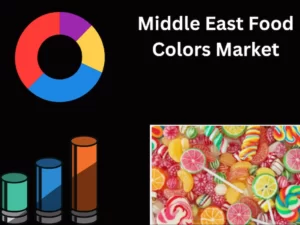© 2024 All rights reserved
Datavagyanik- Your Research Partner

The Middle East region has experienced significant growth in the food and beverage industry in recent years, including the use of food colours. Food colours are used to enhance the visual appeal of food and drinks, making them more attractive and appealing to consumers. With the increasing demand for visually appealing food products, the popularity of food colours has been growing steadily in the region.

Furthermore, consumers in the Middle East have become more health-conscious and are looking for natural and organic food products. This has led to a growing demand for natural food colours made from plant-based sources such as fruits, vegetables, and spices. Additionally, food color manufacturers are now offering a wide range of products that cater to the specific needs and preferences of consumers, such as halal and kosher-certified food colours.
The growing popularity of food colours in the Middle East can also be attributed to the increasing number of food and beverage companies operating in the region. These companies are constantly innovating and introducing new products to meet the changing needs and preferences of consumers. The use of food colours in products such as candies, cakes, and beverages has become more prevalent, making these products more attractive and appealing to consumers.
Middle Eastern desserts often feature bright colours and flavours, such as baklava and Turkish delight.
Red is traditionally considered the luckiest color in Middle Eastern cultures and is often used in special ceremonies and holidays.
Yellow is associated with happiness and joy and is often seen in dishes like saffron rice and kofta.
Orange and yellow are often used together in Middle Eastern cooking, such as in the popular dish of spiced meat and vegetables.
Green is associated with fertility and growth and is used in dishes like tabbouleh and stuffed grape leaves.
Moreover, the Middle East is a region known for its rich cultural heritage and diverse cuisine. Food colours are used in traditional dishes and are an important part of the culinary culture of the region. As a result, the use of food colours has become deeply ingrained in the food culture of the Middle East, further contributing to its growing popularity.
Overall, the growing popularity of food colours in the Middle East can be attributed to the increasing demand for visually appealing and natural food products, the expanding food and beverage industry in the region, and the deep-rooted culinary culture of the Middle East.
Food colours are substances added to food and beverages to enhance their visual appeal or to offset color loss due to processing or storage. There are various types of food colours used in the food industry, including natural, synthetic, naturally-identical, caramel, and others.
Natural food colours are derived from natural sources such as plants, fruits, and vegetables, while synthetic food colours are chemically synthesized in laboratories. Naturally-identical food colours are chemically identical to natural colours but are produced using synthetic methods. Caramel color is derived from caramelized sugar, and other types of food colours include anthocyanins, betanin, and turmeric.
Food colours can be categorized based on their source, which includes plant and animal-based colours, chemical colours, and others. Plant and animal-based colours are derived from natural sources such as vegetables, fruits, and insects. Chemical colours are synthetic colours that are chemically synthesized in laboratories, and other types of colours include metallic colours like gold and silver.
Food colours are available in various forms, including powders, gels, and liquids, and can be used in a variety of food and beverage products such as baked goods, confectionery, beverages, and dairy products.
While the use of natural food colours is growing in popularity in the Middle East due to the increasing demand for healthier and more natural food options, synthetic food colours are still widely used in the food industry due to their stability, consistency, and cost-effectiveness. The increasing demand for processed foods and the growing food industry in the Middle East are contributing to the popularity of food colours in the region.
The Food Colors market in Saudi Arabia is growing due to the increasing demand for food and beverages, as well as an increase in population. The country is becoming more affluent and the middle class is growing, leading to higher disposable incomes, which is driving up demand for convenience foods and speciality items. The government is also promoting the use of more natural and organic food items, which require food colouring agents, further increasing the demand for Food Colors. Additionally, the growth of the tourism industry is increasing the demand for unique, colourful products, such as confectionery, snacks and beverages, which require the use of food colouring agents.
The Food Colors market in the UAE is growing due to the increasing number of international tourists and expatriates in the region. Tourists and expatriates often have higher disposable incomes and are looking for speciality items and convenience foods that require Food Colors to make them visually appealing. Additionally, the government is actively promoting the adoption of healthier food and beverage options, which require Food Colors to make them more attractive to consumers. Furthermore, the growth of the food industry in the UAE is driving up the demand for Food Colors, as the industry is increasingly looking for ways to make products more visually appealing.
The middle east Baby Care Products market has been segmented By Type and By Source.
Based on the By Type, the middle east is Natural, Synthetic, Naturally-identical, Caramel, and Others. In 2021, the synthesis segment held a significant share. Synthetic food colours are artificial colourants added to foods to enhance their appearance. They are used extensively in the food industry and are derived from petroleum or coal tar sources. As such, synthetic food colours can be extremely beneficial to the food industry in terms of improving the look of certain foods while providing an economical solution. For example, synthetic food colours can be used to improve the appearance of beverages, baked goods, confectionery, and dairy products, allowing them to look more attractive and therefore more appealing to the consumer.
Based on the Source, the market is classified as Plant and Animal, Chemicals, and Others. In 2021, the segment is expected to account for a significant share of Plants and Animals. Plant- and animal-sourced food colours are expected to be a major segment of the global plants and animals market in 2021. These colours are derived from natural sources and are used as additives in food to enhance its appearance. They are widely used in the food and beverage industry for colouring products such as dairy products, confectionery, and bakery items. Furthermore, they are also becoming increasingly popular in the cosmetic industry, being used to enhance the colour and texture of makeup and other beauty products. For instance, carmine is a deep red colourant derived from the cochineal insect and is used to give a natural red hue to foods, lipsticks and other cosmetics.
By Type
By Source
By Region
“Every Organization is different and so are their requirements”- Datavagyanik







© 2024 All rights reserved
Datavagyanik- Your Research Partner
Add the power of Impeccable research, become a DV client